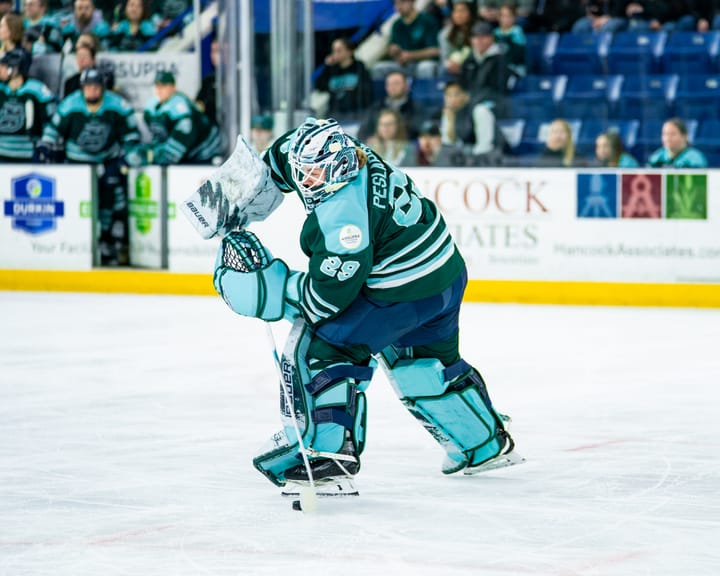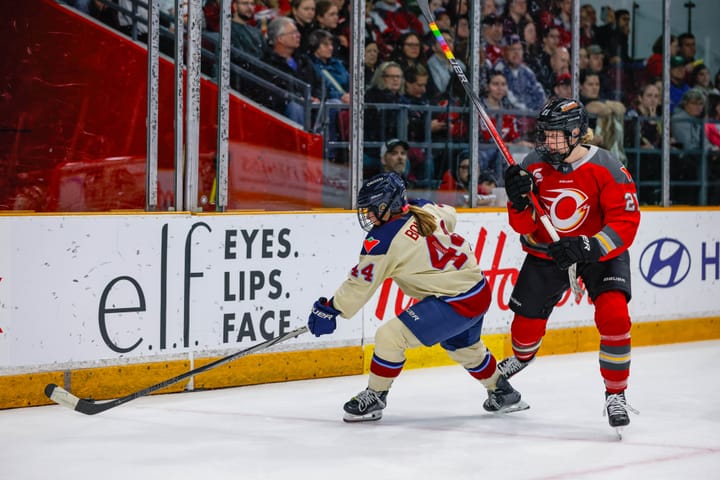A conversation about NCAA DI analytics with Nayan Patel
What DI data is available to the public and what comes next in women’s college hockey analytics
The world of women’s hockey analytics is small, but growing. Over the past few years valuable contributions have been made from voices that are new to the space. Nayan Patel, Mikael Nahabedian, and Dave MacPherson are among a new wave of analysts who are making significant strides with DI women’s hockey data.
In February, Patel gained recognition in the field for presenting a model for predicting the outcome of NCAA DI games at CBJHAC (the Columbus Blue Jackets hockey analytics conference). He works with both men’s and women’s DI data and shares his work through his site, HockeyUAnalytics.com. Patel’s site puts interactive data visualizations for win shares, shot attempts, and more at the fingertips of fellow analysts, media members, players, teams, and fans.
Recently, Patel chatted with The Ice Garden about the state of college hockey analytics despite some highly uncooperative technology.
The Ice Garden: What got you interested in analytics?
Nayan Patel: For me, it got started through my part time job with the Ohio State Athletics Department. I worked in Video Services which meant I was doing things like running the broadcasts, working with cameras, controlling the replay etc. for different OSU athletic events.
I was shooting some of the women’s hockey games and I had the opportunity to talk with Taran Singleton, who was the main Hockey Ops guy for the women’s team. He showed me how my camera feed tied into a whole analytics tracking system that the team was using. Being somebody that has played and followed hockey since I was a little kid, and was always good with math and numbers, it was really fascinating to me.
I started to do my own research by seeing what hockey analytics stuff was out there in the public sphere, and seeing that not many people were doing stuff with college hockey analytics.
TIG: What was your experience at CBJHAC like?
NP: CBJHAC was fantastic! It was my first ever analytics conference, and I was super lucky that it was here in my hometown. I seriously can’t give Alison Lukan enough praise for setting it up and running the whole thing.
It was really cool to be able to meet and interact with people way smarter than I am that I’ve only ever talked to on Twitter before. When the conference was announced, I decided to submit my prediction model that I developed a couple months earlier, just to see what happens. I was lucky enough to be chosen to give a short talk about it! It really gave me perspective seeing some of the crazy brilliant research others are doing and seeing my name next to these folks, being somebody that really only started doing it within the past year. I can’t thank them enough for leading the way for students, like myself, and others just getting into the field.
TIG: How did you decide to work with women’s hockey data in addition to men’s data? Did it come about organically?
NP: Yeah, for me it just kind of happened organically, as you said. As I did research on what kind of data is out there, I noticed that at the DI level for college hockey, the same data that’s available for the men, is also available for the women.
At Ohio State, we are lucky enough to have both competitive men’s and women’s teams over the past five years. I’ve had the pleasure of watching and following both teams as I’ve gone through my undergrad years here, and so naturally when I started this project, I wanted to have the same level of analysis and attention for both, something that traditional media outlets have historically failed to do.
For the public sphere —what data is available for public analysts like myself — the gap is pretty significant.
TIG: In layman’s terms, can you describe what data is available for NHL analysis that is not available for NCAA DI (men’s and women’s)? How big is that gap?
NP: I would say this depends on what sphere we are talking about. For the public sphere —what data is available for public analysts like myself — the gap is pretty significant.
The NCAA’s database is pretty sparse and includes only basic stats. Also, it’s not very user-friendly to access, which leads to people using other third party college hockey sites to get their data. In the NHL, the public has access to a wealth of information coming from their RTSS shot tracking system.
In the private sphere, however, that gap might not be as big as we think. I know certain programs do their own shot tracking and private data collection for team use. Unfortunately, since the individual programs are doing it, none of that will ever be shared publicly and the collection process isn’t standardized across different programs. It’s also only the schools with big budgets that are able to do this in the first place. It’s costly to set up systems with high-tech equipment as well as paying people who can give you actionable insights from that data. It’s just simply not in the budget for smaller schools, for something that, in their eyes, only gives you a marginal competitive advantage.
🚨🚨 win shares charts are UP 🚨🚨https://t.co/0xB6stcwil
— Nayan Patel (@scootszn99) June 14, 2020
skater and goalie data for 19/20 men and women up on the site! The only exception is the LIU women for whatever reason CHN removed the data from their stats page before I scraped it. Hopefully it’s back up soon! pic.twitter.com/35xkLfe7uC
TIG: If you could wave a wand and make any three stats publicly available for NCAA DI hockey, what would they be and why?
NP: The first thing that I would wish for is ice time numbers. You can track all the fancy data you want, but you can’t do anything conclusive with it without putting it in context with a player’s time on ice. People have come up with formulas to calculate an educated guess for a player’s ice time (eTOI), but all that does is put an asterisk next to whatever point you’re trying to make.
The second thing I would want is a standardized shot tracking system set up for all NCAA hockey games. Every shot attempt, where it happened, when it happened, and who was on the ice for both teams among other things. The NHL has had this put in and available to look at publicly for more than 10 years now, and all kinds of super statistically complex metrics have come out of it like expected goals or wins above replacement. This could really help us understand the sport at the college level to a degree we haven’t yet and bring up public analysis to NHL-level.
The final thing I would wish for is transitions data. Tracking zone entries and exits and other microstats can help us understand systems play and how college teams play differently from one another as well as compared to other leagues.
TIG: What comes next for college hockey analytics?
NP: Honestly, I think the “analytics revolution” so to speak for college hockey is going to come at a much slower pace than the NHL and other foreign leagues. The reality of it is the NCAA is the only one that can bring about the next big change in college hockey analytics. However, they have so many other sports to attend to, as well as so many other more pressing issues that they need to solve.
College hockey is one of the lower revenue sports for the NCAA, and thus, as with any big corporation, less attention is paid to it. My guess is the next thing to happen in college hockey analytics is improvements to the overall statistical collection and publishing process. Their databases are small, hard to go through, and riddled with errors. I think that they need to standardize processes among all schools, clean up their databases, and publish it online in a more user friendly format.
top 5 player in college hockey this season it's as simple as that https://t.co/WcMpR58Wjb pic.twitter.com/Y6lQsHdCdN
— Nayan Patel (@scootszn99) May 26, 2020
TIG: A big question related to women’s hockey analytics that I hope to approach one day is how the “no hitting” rule impacts possession. Are there any big questions you hope to answer with your work down the line?
NP: I think it’s a really great question to look at given that it’s the main difference between the men’s and women’s games. Just from watching so many of these games, you see that the no hitting rule really impacts how the game is played differently, on a systems level. Using the “eye test”, as some like to call it, you can see, for example, that the men tend to prefer dumping and chipping the puck in and entering the zone with more speed, while crashing.
For the women, since you can’t be hit off the puck, there’s more controlled zone entries. They have more time and freedom to set up and devise controlled puck movements and plays. For the men, it’s more about creating opportunities and space by drawing your opponent out of position. While these are just things I’ve observed, it would be really cool to dig into the data and see which strategies lead to more possession as well as more scoring chances. I would have to think that given the style of play, there’s way more of an emphasis on puck possession in the women’s game, but it would be interesting to see if the data supports that.
Portions of this interview were edited for brevity and clarity.





Comments ()